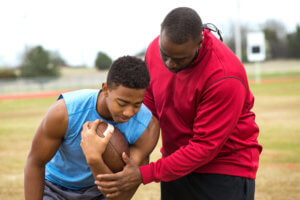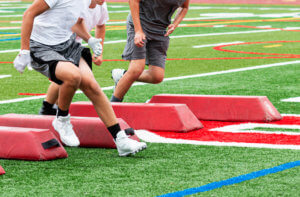The Most Common Football Ankle Injury Might Not Be What You Think
Although concussions are common in football — and one of the most talked-about risks in the sport — the rough and tumble nature of gridiron action also means athletes are at risk for a host of foot and ankle injuries. From tendonitis and sprains to fractures and ruptured tendons, injuries to the feet and ankles can take a player out of the action for a few days or the entire season.

Understanding how these injuries occur, how they are treated, and (most importantly) how to avoid them can keep players off the sidelines, and in the action through the post-season. At South Island Orthopedics, we’ve seen all manner of football ankle injuries. Our team of board-certified orthopedic surgeons is ready to provide advanced treatments to help you heal, and get back on the field as soon as possible.
The Most Common Football-Related Foot and Ankle Injuries
Although these aren’t the only ankle injuries possible in football, they are the most common, and the most likely to land you in the orthopedic surgeon’s office.
Ankle Sprains
Sprained ankles are the most common injury in any fall sport, including football, soccer, and field hockey. In fact, almost 70% of injuries in soccer are sprained ankles.
A sprain refers to the stretching, rupture, or damage to a ligament in the ankle. Ligaments are thick bands of tissue that connect bones, usually crossing over the bones. In football, sprains can be medial, lateral, or high ankle sprains.
Medial Sprains
A medial sprain is damage to the ligament on the inside of the ankle. Although rare in typical day-to-day activities because it’s uncommon for the ankle joint to roll inwards, it’s common in football (and soccer). A medial sprain is a contact injury: Either you contacted something or something made contact with you — such as another player during a tackle — that caused the joint to roll that way and stretch the ligament.
Lateral Sprains
A lateral sprain, on the other hand, is damage to the outer ligament. This is usually caused by rolling the ankle, but like a medial sprain, it can also be caused by contact.
High-Ankle Sprain
A high-ankle sprain is the least common, but most painful and debilitating sprain. As the name implies, the ligaments higher on the ankle are damaged, usually by a twisting or rotating motion.
Sprains are evaluated on a grading system, from 1 (mild) to 3 (a complete ligament tear). In most cases, rest and immobilization, followed by a gradual return to activity, are the only treatment. Sprained ankle recovery time can vary from as little as two weeks to up to 3-4 months. Surgery is only needed in rare cases when non-surgical treatments don’t work and the ankle is still unstable months after the injury.
Fractures 
Fractures are another common football-related injury. Tibia and fibula fractures — breaks in the lower leg bones — may occur with a high-ankle sprain, and are most commonly associated with tackling. However, other fractures, including ankle stress fractures and Jones fractures, are more common.
Stress Fracture
An ankle stress fracture is a tiny crack (or series of cracks) in the bone. Stress fractures are associated with sports that involve lots of running. While minor compared to some other ankle injuries, stress fractures can be very painful and debilitating. They can also be challenging to diagnose, as the cracks may not be visible on X-rays.
Jones Fracture
A Jones fracture is a specific type of fracture that affects the fifth metatarsal in the foot. This is the outermost foot bone that connects to the pinky toe. A Jones fracture is a recurring stress fracture that’s typically caused by running or repetitive motions (like jumping), but is also associated with rolled ankles. The injury causes pain in the outer or middle part of the foot.
Most stress fractures are treated with immobilization and rest. Some athletes require physical therapy to strengthen the ankle joint and surrounding muscles to prevent recurrent fractures. Tibia and fibula fractures, as well as Jones fractures that do not heal, usually require surgery.
Achilles Tendon Injuries 
The Achilles tendon runs down the back of the leg and connects the heel. Although anyone can injure their Achilles, it’s especially common in football. Football players are prone to two injuries in particular: Achilles tendonitis and a ruptured Achilles.
Achilles Tendonitis
Achilles tendonitis refers to inflammation of the tendon caused by increasing the frequency and intensity of workouts. Putting excessive stress and overuse on the calf muscles can cause pain in the Achilles. Treatment usually involves rest and strengthening exercises.
Ruptured Achilles
A ruptured Achilles means that the Achilles tendon has partially or completely torn. Forceful movements and sudden accelerations — two of the foundations of football — can cause this ankle injury. Treatment depends on the severity of the injury, but a ruptured Achilles often means surgery.
Preventing Football Ankle Injuries
Many foot and ankle injuries in football and other fall sports are preventable with the right conditioning and equipment. Keep these tips in mind to stay in the game all season.
- Wear the proper footwear for the sport. Ideally, football players should wear football cleats with ankle support to prevent rolling the joint. All footwear should be properly fitted to your foot type.
- Warm up your muscles with dynamic stretching before working out, or performing static stretches.
- Gradually condition your body for the sport. Increase the intensity and duration of your workouts over several weeks.
- Consider wearing a brace or using tape to add support to your ankles if you are prone to injuries.
- Listen to your body. If you have pain in your foot or ankle, stop and have the team trainer or medical personnel examine the injury.
South Island Orthopedics is Here When You Need Us
If you or your child is injured playing football or any other sport, don’t wait to get medical treatment. Seeing an orthopedic specialist for an ankle injury as soon as possible ensures proper treatment and may even help you avoid needing future surgery.
To ensure Long Island athletes have access to the care they need when they need it, we have two convenient urgent care locations in Cedarhurst and Woodbury. While we encourage appointments, we also accept walk-ins when you have an acute injury. Both locations are equipped with X-ray and MRI equipment, ensuring you can get a fast diagnosis and begin treatment right away.
If you need to make an appointment, call the Cedarhurst office at 516-295-0111, or the Woodbury office at 516-364-0070. You can also request an appointment in our new Rockville Centre location by calling 516-665-9200.
South Island Orthopedics’ Guide to Bone and Joint Care

Posted in: Ankle, Sports Medicine
